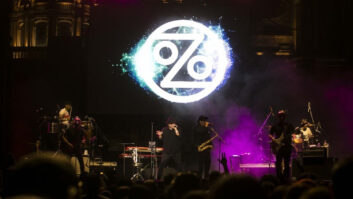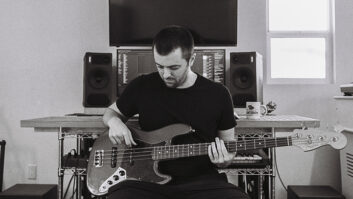Jewel’s story is one of perseverance. The press has filled volumes with her rags-to-riches saga; so, many of us know by now that she is a native Alaskan who struck out on her own at a young age with dreams of making it big as a singer. She arrived in the Lower 48 with little more than the clothes on her back, a developing urge to write songs and a captivating voice capable of ranging across almost four octaves. She paid her dues in coffeehouses and small clubs across America, sleeping in her car more than a few times until finally gaining the attention of Atlantic Records.
Throughout 1997, the song-stress toured with traditional folkie flair. Framed only by a cocktail drum kit, acoustic bass, and acoustic guitar, her sets showcased her mesmerizing vocals, dynamic range and seemingly tireless strength as a singer. Beginning in February of this year, however, Jewel’s career has departed from this Spartan path.
“This time out we rock,” says FOH engineer Rob Howick, speaking from the production office at Woodlands Pavilion outside of Houston on July 10. Howick is currently out with Jewel’s world tour in support of her latest Atlantic release, Spirit. “There are still plenty of folk-inspired moments,” says Howick, “but for the first time, Jewel is being backed by a group of seriously talented musicians on electric bass, electric guitar, keys, and drums.”
Joining Jewel this time out are Douglas Price Pettibone on electric guitar, Steve George (of mid-’80s Mr. Mister fame) on keys, mentor and co-writer Steve Poltz on acoustic guitar, and the New Orleans duo of Tony Hall on electric bass and Brady Blade on drums.
For sound reinforcement, the act relies upon an Electro-Voice X-Array system. Driven by QSC PowerLight amplifiers, the rig is supplied by Winnipeg-based Sound Art Canada and was assembled by Sound Art’s Dave Cousins. Howick’s FOH console is a Midas Heritage 3000 (48x18x2), and monitor engineer Colm O’Reilly operates a Midas XL250 (52×20). The sound crew also includes chief Mike Brownlee and FOH systems engineer George Addis.
The Spirit tour has carved a long swath across the globe since February. Beginning with more intimate, soft-seated venues down under, the tour moved on to New Zealand, Singapore, Malaysia, Japan, the UK and other European stops. Within the confines of its current U.S. sheds’n’hockey rinks incarnation, the show runs anywhere from 90 to 120 minutes and is divided into three segments: The first features the full band, the second is Jewel’s solo section, and the third finds the musicians turning it up in what the star herself describes as “rock/ chick mode.”
“As the tour has progressed, the musicians have grown comfortable with their roles,” Howick says. “When this happened, they brought a lot of additional energy to the act. As a result, Jewel was forced to sing harder to hear herself onstage. That, combined with the wear and tear of constant performing, took a toll on her voice.
“Toward the end of our European dates, she strained her vocal chords. We were forced to cancel some dates. To avoid the prospect of damaging her voice any further, I suggested that some significant steps be taken to create a better onstage environment that would be less fatiguing.”
NO MORE HANGOVERSHowick and O’Reilly set about bringing the stage volumes down. They developed a monitoring setup that eliminated just about every monitor onstage, as well as all guitar and bass cabinets. To replace the wedges and sidefills, the band was outfitted with Shure PSM 600 personal monitor systems, providing each musician with an adjustable in-ear stereo mix via custom dual-driver ear pieces. Jewel herself uses an ear piece in one ear and a solid plug in the other. X-Array Xw low-profile biamped wedges positioned in front of her allow O’Reilly to bring the mix back to the floor should the singer so desire.
“The band has adapted to in-ear monitoring really well,” Howick says. “Now they wake up each morning without a trace of noise hangover, which has them thanking us profusely for switching them over. As intended, our stage volumes are way down as well, removing a lot of the strain on Jewel.”
NATURAL SOUNDBorrowing a common studio technique for live performance, Howick made new offstage homes for the guitar and bass cabinets, removing them to isolation chambers on the loading dock or upstage behind the backdrops. Made from large road cases and their covers, each isolation chamber offers about three feet of space inside to “play around with,” and Howick places a pair of microphones in each, allowing him to vary each instrument’s sound according to the needs of the set list. In the cabinets for Douglas Price Pettibone’s and Jewel’s electric guitars, Howick has Audio-Technica AT4050 condenser mics mounted up tight against the loudspeaker, with Shure KSM32s set farther back within each enclosure.
Around ten different microphones were tried on Jewel’s voice during tour rehearsals. “Now that we’re more into a rock-oriented scenario, I wanted something that was predictable and dependable,” Howick says. He chose a Shure U2/Beta 58 UHF wireless unit. “In the days of our folk-dominated sound, Jewel used an Audix mic with a Turbosound P.A. That setup worked nicely then, but this time I wanted her vocal to cut right through the mix and cover the whole audience. For this application, [the Shure U2/Beta 58] had the truest, most natural sound.”
All other vocal mics, including Jewel’s backup, are hard-wired Beta 58As. At the Plexiglas-isolated drum kit, AKG C414 condensers are used on overheads, and a Shure Beta 91 condenser boundary mic is mounted inside the kick drum. A Beta 98A miniature condenser, is used on toms and djembe top; a Beyerdynamic M88 is at djembe bottom. Snares are captured topside by a Beta 57A, and at floor level by a unique choice-the articulating Beta 52. A dozen Klark Teknik LBB100 active DIs are used on keys, bass and acoustic guitars.
A pair of programmable Klark Teknik DN3600 dual third-octave equalizers are used on monitors and FOH electronics. Also in the racks are a Drawmer DL251 stereo compressor a Brooke-Siren TCS-804 delay and a KT DN6000 11/46-octave time and frequency analyzer. For system tuning, Howick has found the SIA SMAART Pro system especially useful.
RECIPES FOR EFFECTSHowick’s selection of effects fits with Jewel’s newly developed rock edges. His “rock ‘n’ roll special” for Douglas Price Pettibone’s electric guitar solos is a Roland SDE3000 digital delay, which is also used for double-slap on Jewel. A TC Electronic M2000 is split into reverb and chorus modes for acoustic guitars, and a Lexicon PCM 90 is used to create different snare and tom sounds. He uses a Lexicon 480L digital reverb on vocals to enhance spatial qualities, and Aphex 622 frequency-conscious, dual-channel noise gates are applied to the kick drum, snares and toms, as well as the M88 at djembe bottom.
A couple of hot spots in Jewel’s vocals warrant the use of a pair of Summit DCL-200 dual-channel valve compressors, which work in conjunction with a pair of Brooke-Siren DPR901-II dual-channel dynamic equalizers on all her mics to keep things from suddenly taking off at the offending frequencies.
“This is Jewel’s show, so you’re going to hear her voice first and foremost each night,” Howick says. “After that, you almost get a studio band now that we’ve virtually cleaned everything off of the stage and put Plexiglas around the drum kit. It’s a very controlled atmosphere, an ideal situation for me. Now I can set up a really nice stereo image that moves around quite a bit during the night with an amazing fluidity. Different energies and personalities emerge freely. The potential to get creative is almost limitless. It will be interesting to see how we continue to evolve from tour to tour.”






